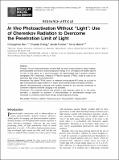In Vivo Photoactivation Without “Light”: Use of Cherenkov Radiation to Overcome the Penetration Limit of Light
Author(s)
Moore, Anna V; Ran, Chongzhao; Zhang, Zhaoda; Hooker, Jacob
Download11307_2011_Article_489.pdf (485.2Kb)
PUBLISHER_POLICY
Publisher Policy
Article is made available in accordance with the publisher's policy and may be subject to US copyright law. Please refer to the publisher's site for terms of use.
Terms of use
Metadata
Show full item recordAbstract
Purpose
The poor tissue penetration of visible light has been a major barrier for optical imaging, photoactivatable conversions, and photodynamic therapy for in vivo targets with depths beyond 10 mm. In this report, as a proof-of-concept, we demonstrated that a positron emission tomography (PET) radiotracer, 2-deoxy-2-[[superscript 18]F]fluoro-d-glucose ([superscript 18]FDG), could be used as an alternative light source for photoactivation.
Procedures
We utilized [superscript 18]FDG, which is a metabolic activity-based PET probe, as a source of light to photoactivate caged luciferin in a breast cancer animal model expressing luciferase.
Results
Bioluminescence produced from luciferin allowed for the real-time monitoring of Cherenkov radiation-promoted uncaging of the substrate.
Conclusion
The proposed method may provide a very important option for in vivo photoactivation, in particular for activation of photosensitizers for photodynamic therapy and eventually for combining radioisotope therapy and photodynamic therapy.
Date issued
2011-05Department
Massachusetts Institute of Technology. Institute for Medical Engineering & Science; Martinos Imaging Center (McGovern Institute for Brain Research at MIT); Harvard University--MIT Division of Health Sciences and Technology; McGovern Institute for Brain Research at MITJournal
Molecular Imaging and Biology
Publisher
Springer-Verlag
Citation
Ran, Chongzhao et al. “In Vivo Photoactivation Without ‘Light’: Use of Cherenkov Radiation to Overcome the Penetration Limit of Light.” Molecular Imaging and Biology 14.2 (2012): 156–162.
Version: Author's final manuscript
ISSN
1536-1632
1860-2002